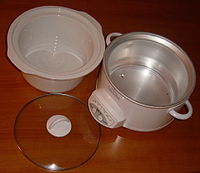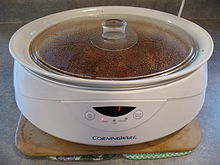- Slow cooker
-
A slow cooker, Crock-Pot (a US trademark that is often used generically), or Slo-Cooker (a UK trademark that is often used generically) is a countertop electrical cooking appliance that allows moist-heat cooking method of simmering which requires maintaining a relatively low temperature compared to other cooking methods (such as baking, boiling, and frying),[1] for many hours allowing unattended cooking of pot roast, stew, and other suitable dishes.
Contents
History
The Naxon Utilities Corporation of Chicago developed the Naxon Beanery All-Purpose Cooker.[2] The Rival Company bought Naxon in 1970 and reintroduced it under the Crock-Pot name in 1971. In 1974, Rival introduced removable stoneware inserts.[3] The brand now belongs to Sunbeam Products, a subsidiary of Jarden Corporation. Other brands of this appliance include Hamilton Beach, West Bend Housewares, GE, Magic Chef, and former American Electric Corporation.
Design
A basic slow cooker consists of a lidded round or oval cooking pot made of glazed ceramic or porcelain, surrounded by a housing, usually metal, containing an electric heating element. The lid is often of glass seated in a groove in the pot edge; condensed vapour collects in the groove and provides a low-pressure seal to the atmosphere. The contents of a crock pot are effectively at atmospheric pressure, despite the water vapor generated inside the pot. A crock pot is quite different from a pressure cooker and presents no danger of an abrupt pressure release.
The ceramic pot, or 'crock', acts as both a cooking container and a heat reservoir. Slow cookers come in capacities from 500 ml (16 oz) to 7 liters (7.4 US quarts). Due to the placement of heating elements (generally at the bottom and often also partway up the sides), there is usually a minimum recommended liquid level to avoid uncontrolled local heating.
Many slow cookers have two or more heat settings (e.g., low, medium, high, and sometimes a "keep warm" setting); some have continuously variable temperature. A typical slow cooker is designed to heat food to 77 °C (170 °F) on low, to perhaps 88-93 °C (190-200 °F) on high. Many recipes that include sauce or liquid will reach the boiling point around the edges, while food in the center remains gently cooked. This may be because slow cooker settings are based on wattage, not temperature.[4]
Operation
Raw food and a liquid such as water, wine, or stock are placed in the slow cooker. Some recipes call for pre-heated liquid. The cooker lid is put on and the cooker is switched on. Some cookers automatically switch from cooking to warming (maintaining the temperature at 71–74 °C [160–165 °F][5]) after a fixed time or after the internal temperature of the food, as determined by a probe, reaches a specified value.
The heating element heats the contents to a steady temperature in the 79–93 °C (175–200 °F) range. The contents are enclosed by the crock and the lid, and attain an essentially constant temperature. The vapor that is produced at this temperature condenses on the lid and returns as liquid. Some water-soluble vitamins are leached into the liquid.[6]
The liquid transfers heat from the pot walls to its contents, and also distributes flavours. A lid is essential to prevent warm vapour from escaping, taking heat with it and cooling the contents.
Basic cookers, which have only high, medium, low, or keep warm settings, have to be manually turned on and off. Others have settings for high and low (e.g., four hours high, eight hours low) which allow the cook to choose a cooking time after which the cooker switches to "keep warm" mode. The most advanced cookers have computerised timing devices that allow the cooker to be programmed to perform multiple operations (e.g., two hours high, followed by two hours low, followed by warm), and to delay the start of cooking.
Because food stays warm for a long time after switching off, slow cookers can be used to cook food to be taken to be eaten elsewhere without reheating. Some cookers have ways of sealing the lid to prevent the contents from spilling during transport.
Recipes
Recipes intended for other cooking methods must be modified for slow cookers. Quantities of liquids may have to be adjusted as there is little evaporation, but there should be enough liquid to cover the food. Many published recipes for slow cookers (aka crock-pots) are designed primarily for convenience and use few ingredients, often prepared sauces. The long, moist cooking is particularly suitable for tough and cheap cuts of meat—for many slow-cooked dishes these cuts give better results than more expensive ones.
Advantages
Cheaper cuts of meat with connective tissue and lean muscle fibre are suitable for stewing, and tastier than stews using expensive cuts,[7] as long slow cooking will soften the connective tissue without toughening the muscle. Slow cooking leaves the gelatinised tissue in the meat, so that it may be advantageous to start with a richer liquid.
The low temperature of slow-cooking makes it impossible to burn food even if cooked too long; however, meat and vegetables will become nearly tasteless or "raggy" if overcooked.
Food can be set to slow-cook before leaving for the day, and will be ready on return. Some models include timers or thermostats which bring food to a given temperature, and then lower it. With a timerless cooker it is possible to use an external timer to stop cooking after a set time, or both to start and stop.
Cooking the meal in a single pot reduces washing up, and the low cooking temperature and glazed pot make cleaning easy.
Disadvantages
Some vitamins and other trace nutrients are lost, particularly from vegetables, partially by enzyme action during cooking and partially due to heat degradation/evaporation. When vegetables are cooked at higher temperatures these enzymes are rapidly denatured and have less time in which to act during cooking. Since slow cookers work at temperatures well below boiling point and do not rapidly denature enzymes, vegetables tend to lose trace nutrients. Blanched vegetables, having been exposed to very hot water, have already had these enzymes rendered largely ineffective, so a blanching or sauteing pre-cook stage will leave more vitamins intact.[8] This is often a smaller nutrient loss than over-boiling and can be lessened to an extent by not removing the lid until the food is done.
Raw kidney beans, and to a lesser extent some other beans (such as broad/fava beans), contain the toxin phytohaemagglutinin, which is destroyed by boiling for at least ten minutes, but not by the lower temperatures of a slow cooker, so dry beans must be boiled prior to slow cooking to avoid poisoning. Even a few beans can be toxic, and beans can be as much as five times more toxic if cooked at 80 °C (175 °F) than if eaten raw, so adequate pre-boiling is vital. Cases of poisoning by slow-cooked beans have been published in the UK; poisoning has occurred in the USA but has not been formally reported. This risk can be avoided entirely by using canned cooked beans, adding them towards the end of the recipe's cooking time.[9]
Slow cookers do not provide sufficient heat to compensate for loss of moisture and heat due to frequent removal of the lid, e.g., to add and remove food in perpetual stews, (pot au feu, olla podrida). Added ingredients must be given time to cook before the food can be eaten. If food is allowed to cool below about 70 °C (158 °F) and not reheated, harmful bacterial growth is possible; some bacteria produce toxins or spores which are not destroyed even by reheating.
Hazards
Slow cookers are less dangerous than ovens or stove tops due to the lower temperatures and closed lids. However, they still contain a large amount of near boiling temperature food and liquid and can cause serious burns if spilled. Children may be at risk due to the high temperatures.
See also
References
- ^ Gisslen, Wayne, Professional cooking, 7th ed., John Wiley & Sons, Inc.. 2011, p.71
- ^ photograph at
- ^ "Crock Pot brand page". Crock-pot.ca. http://www.crock-pot.ca/CustomerService.aspx?id=abo. Retrieved 2011-07-26.
- ^ "At what temperature does a Crock Pot cook on Low and High?". http://answers.yahoo.com/question/index?qid=20080109140202AAfyGME. Retrieved 2009-07-07.
- ^ "Faq Answers". Crock-pot.ca. http://www.crock-pot.ca/faqanswers.aspx?fId=610. Retrieved 2010-02-09.
- ^ by the Editors of Easy Home Cooking Magazine. "HowStuffWorks". Recipes.howstuffworks.com. http://recipes.howstuffworks.com/slow-cooker-questions.htm. Retrieved 2010-02-09.
- ^ Heston Blumenthal (2002-12-07). "Take your time | Life and style". London: The Guardian. http://www.guardian.co.uk/lifeandstyle/2002/dec/07/foodanddrink.shopping. Retrieved 2010-02-09.
- ^ "National Center for Home Food Preservation". University of Georgia. http://www.uga.edu/nchfp/how/freeze/blanching.html. Retrieved 2010-02-10.
- ^ "Foodborne Pathogenic Microorganisms and Natural Toxins Handbook: Phytohaemagglutinin". Bad Bug Book. United States Food and Drug Administration. http://www.fda.gov/Food/FoodSafety/FoodborneIllness/FoodborneIllnessFoodbornePathogensNaturalToxins/BadBugBook/ucm071092.htm. Retrieved 2009-07-11.
Cooking techniques Dry ConductionConvectionRadiationWet High heatLow heatIndirect heatFat-based High heatBlackening · Browning · Frying (Deep frying · Pan frying · Shallow frying · Stir frying (bao)) · SautéingLow heatMixed medium Device-based Non-heat See also Categories:- Cooking appliances
- Cooking techniques
Wikimedia Foundation. 2010.


